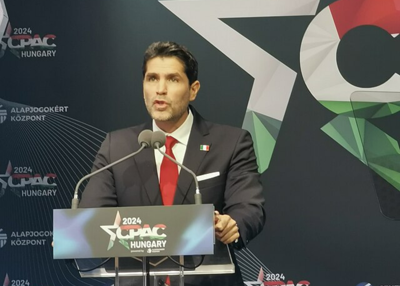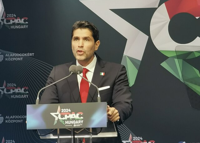
Mexican right wing extremist Eduardo Verástegui at CPAC Hungary 2024 in Millenáris, Budapest, Central Europe. (Elekes Andor/Wikimedia Commons)
The recent image of Mexican actor, singer and producer Eduardo Verástegui imitating Hitler's Nazi salute should not come as a surprise.
Instead, it should serve as a wake-up call to examine Mexico's history and the persistent influence of far-right ideology in its modern politics and society.
Mexico has long been home to right-wing extremism, with roots stretching back nearly a century. In 1929, Belgian nationalist Léon Degrelle arrived in Mexico to witness the revolution first-hand, drawn by the religious fervor of the Cristero Rebellion. With the help of the few landowners and caciques who were opposed to the distribution of land, they managed to spread propaganda from the atrium that reached the poor peasants who believed that the government was prohibiting religion.
Degrelle was a journalist for a conservative Belgian magazine. He returned to Europe inspired by the movement and Inspired by the motto "Viva Cristo Rey" (Christus Rex), Degrelle created Rex magazine. He later founded the Rexist Party, a fascist organization. By 1940, during the Nazi occupation of Belgium, although the Catholic Church in Belgium reproached and rejected his religious Catholic extremism and his supremacist ideology, Degrelle would be an ally of the Nazi invaders. After the war, Degrelle was exiled and found asylum in Spain under the fascist dictator Francisco Franco.
The Cristero War's unresolved tensions laid the groundwork for Mexico's own brand of ultra-conservatism. The outcome of the Cristero War, after agreements (arreglos) between the Vatican Clergy, the Mexican government and the intervention of oil tycoons through the United States Ambassador Dwight Morrow and John Burke at the National Catholic Welfare Conference did not satisfy the extreme right.
The admiration for Nazi Germany was not just ideological; it was embedded in Mexico's political and cultural elite. Nazi spy Hilde Krüger infiltrated Mexican high society in the 1940s, forging relationships with President Miguel Alemán and actors of the Golden Age of Mexican cinema. Before arriving in Mexico, she had ties to Hollywood elites and European fascists, seamlessly integrating herself into the upper echelons of power. The presence of Nazi sympathizers within Mexico's ruling class underscores the extent to which far-right ideologies were tolerated and, at times, embraced.
The far-right's reach extended into intellectual circles, with prominent figures such as Mexican writer, philosopher, and politician José Vasconcelos glorifying the Nazi regime in publications like El Timón.
At the epicenter of the Cristero War, after the agreements, an ultra-right movement was created that would be influential in political and social life in Mexico. By 1937, the National Synarchist Union (UNS) had emerged in León, Guanajuato, becoming a potent force in Mexican politics aimed to counteract socialist and Marxist influences.
By the mid-20th century, the far-right had firmly embedded itself within Mexico's political institutions. The National Action Party (PAN) emerged as a counterweight to socialist and leftist movements, aligning itself with conservative Catholic groups such as Movimiento Universitario de Renovadora Orientación (MURO) and Tarea Educativa y Cultural hacia el Orden y la Síntesis (TECOS). These student organizations acted as militant enforcers, suppressing leftist movements within universities.
Meanwhile, conservative factions exerted control over the media, using film and television to promote religious and nationalist ideals. The Catholic Church, through organizations like Juventud Católica Femenina Mexicana, reinforced these narratives ensuring that Mexican society remained steeped in conservative values in films in the 1950s.
By the 1970s and 1980s, major advertisers such as Bimbo played a crucial role in sustaining conservative ideological rhetoric in television. Bimbo's owner, Lorenzo Servitje, was in charge of boycotting the television station that was in charge of denouncing the sexual abuse of the founder of the Legionaries of Christ, Father Marcial Maciel. Mexican television was in charge of promoting family values, morals and respect for the Catholic Church and national heroes.
In the 1990s, neoliberal technocrats within the Institutional Revolutionary Party (PRI) re-established diplomatic ties with the Vatican, reversing Mexico's secularist policies dating back to the 19th century when Benito Juarez decided to cut ties with the Church during la Guerra de Reforma. By 1992, President Carlos Salinas de Gortari had solidified this rapprochement, paving the way for the infiltration of ultraconservative Catholic factions.
The secret society known as El Yunque, long suspected of orchestrating right-wing political maneuvers, gained unprecedented access to power through the PAN. Journalist Álvaro Delgado exposed their operations in 2003, revealing how they had successfully placed members within the administrations of Presidents Vicente Fox and Felipe Calderón.
In the 2010s, the digital revolution disrupted the far-right's hold on Mexico's information landscape. The rise of social media and independent news platforms provided alternative narratives, challenging the dominance of Televisa and TV Azteca. This shift played a crucial role in the political ascent of Andrés Manuel López Obrador and the left-wing Morena party. By democratizing access to information, these platforms empowered marginalized voices, weakening the once-unchallenged influence of conservative media conglomerates.
Yet, the far-right has not disappeared. Displaced by the left's rise, ultraconservatives have sought new avenues for influence.
Verástegui embodies this revival, using his platform as a Catholic filmmaker to champion reactionary causes. His alignment with figures like Santiago Abascal, leader of Spain's far-right Vox party, signals a concerted effort to revive Mexico's conservative movement. His appearance at the CPAC convention, punctuated by a Nazi salute, is not an isolated incident—it is the latest manifestation of an enduring ideological struggle.
The persistence of the far-right in Mexico serves as a reminder that history is never truly buried. Verástegui has organized CPAC Mexico, and he wants to create an ultra-right party in Mexico. He has TV Azteca owner Ricardo Salinas Pliego as his main ally.
While the country has made strides toward progressive governance, the ghosts of its conservative past continue to haunt its political landscape.
This ideology crossed borders and has been expressed without resentment since the arrival of Donald J. Trump to the presidency. Like Verástegui, the ultra-right conservative nationalists will not be ashamed to hide their supremacist ideology. The challenge moving forward is to remain vigilant, ensuring that democracy and pluralism prevail over extremism and intolerance.











(0) comments
Welcome to the discussion.
Log In
Keep it Clean. Please avoid obscene, vulgar, lewd, racist or sexually-oriented language.
PLEASE TURN OFF YOUR CAPS LOCK.
Don't Threaten. Threats of harming another person will not be tolerated.
Be Truthful. Don't knowingly lie about anyone or anything.
Be Nice. No racism, sexism or any sort of -ism that is degrading to another person.
Be Proactive. Use the 'Report' link on each comment to let us know of abusive posts.
Share with Us. We'd love to hear eyewitness accounts, the history behind an article.